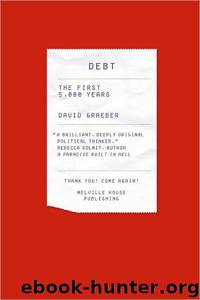Debt: The First 5,000 Years by David Graeber

Author:David Graeber
Language: eng
Format: mobi, epub
Tags: Non-fiction, History
ISBN: 9781612190983
Publisher: Melville House
Published: 2010-01-02T00:00:00+00:00
The Near West:
Islam (Capital as Credit)
Prices depend on the will of Allah; it is he who raises and lowers them.
—Attributed to the Prophet Mohammed
The profit of each partner must be in proportion to the share of each in the adventure.
Islamic legal precept
For most of the Middle Ages, the economic nerve center of the world economy and the source of its most dramatic financial innovations was neither China nor India, but the West, which, from the perspective of the rest of the world, meant the world of Islam. During most of this period, Christendom, lodged in the declining empire of Byzantium and the obscure semi-barbarous principalities of Europe, was largely insignificant.
Since people who live in Western Europe have so long been in the habit of thinking of Islam as the very definition of “the East,” it’s easy to forget that, from the perspective of any other great tradition, the difference between Christianity and Islam is almost negligible. One need only pick up a book on, say, Medieval Islamic philosophy to discover disputes between the Baghdad Aristoteleans and the neo-Pythagoreans in Basra, or Persian Neo-Platonists—essentially, scholars doing the same work of trying to square the revealed religion tradition beginning with Abraham and Moses with the categories of Greek philosophy, and doing so in a larger context of mercantile capitalism, universalistic missionary religion, scientific rationalism, poetic celebrations of romantic love, and periodic waves of fascination with mystical wisdom from the East.
From a world-historical perspective, it seems much more sensible to see Judaism, Christianity, and Islam as three different manifestations of the same great Western intellectual tradition, which for most of human history has centered on Mesopotamia and the Levant, extending into Europe as far as Greece and into Africa as far as Egypt, and sometimes farther west across the Mediterranean or down the Nile. Economically, most of Europe was until perhaps the High Middle Ages in exactly the same situation as most of Africa: plugged into the larger world economy, if at all, largely as an exporter of slaves, raw materials, and the occasional exotica (amber, elephant tusks …), and importer of manufactured goods (Chinese silks and porcelain, Indian calicoes, Arab steel). To get a sense of comparative economic development (even if the examples are somewhat scattered over time), consider the following table:58
Populations and Tax Revenue, 350 BC–1200 AD
Download
This site does not store any files on its server. We only index and link to content provided by other sites. Please contact the content providers to delete copyright contents if any and email us, we'll remove relevant links or contents immediately.
International Integration of the Brazilian Economy by Elias C. Grivoyannis(99042)
The Radium Girls by Kate Moore(11975)
Turbulence by E. J. Noyes(7980)
Nudge - Improving Decisions about Health, Wealth, and Happiness by Thaler Sunstein(7659)
The Black Swan by Nassim Nicholas Taleb(7058)
Rich Dad Poor Dad by Robert T. Kiyosaki(6514)
Pioneering Portfolio Management by David F. Swensen(6257)
Man-made Catastrophes and Risk Information Concealment by Dmitry Chernov & Didier Sornette(5957)
Zero to One by Peter Thiel(5735)
Secrecy World by Jake Bernstein(4701)
Millionaire: The Philanderer, Gambler, and Duelist Who Invented Modern Finance by Janet Gleeson(4425)
The Age of Surveillance Capitalism by Shoshana Zuboff(4247)
Skin in the Game by Nassim Nicholas Taleb(4205)
Bullshit Jobs by David Graeber(4141)
The Money Culture by Michael Lewis(4135)
Skin in the Game: Hidden Asymmetries in Daily Life by Nassim Nicholas Taleb(3962)
The Dhandho Investor by Mohnish Pabrai(3725)
The Wisdom of Finance by Mihir Desai(3696)
Blockchain Basics by Daniel Drescher(3541)
